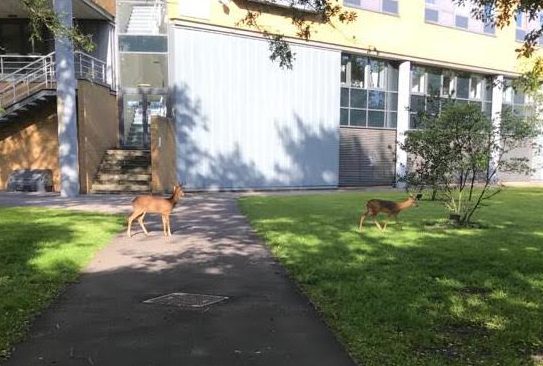 Abraham Lincoln
If given the truth, the people can be depended upon to meet any national crisis...
Abraham Lincoln
If given the truth, the people can be depended upon to meet any national crisis...
 Guildford news...
for Guildford people, brought to you by Guildford reporters - Guildford's own news service
Guildford news...
for Guildford people, brought to you by Guildford reporters - Guildford's own news service
Stag Hill By Name and Now Stag Hill By Nature
Published on: 16 May, 2020
Updated on: 22 May, 2020
Stag Hill is believed to be so named because it was on the southern end of Forest of Windsor, reserved in medieval times for royal hunting parties.
But since Guildford Cathedral and the University of Surrey were built on the hill in the last century deer, some of England’s largest wild animals and the former huntsman’s quarry, have been understandably absent. But things are changing.
The two most common species of deer in Surrey are, fallow deer, with white spots on their flanks, and roe deer. The deer in the photos are roe deer and are usually associated with the edges of woodlands and forests. They are also found in areas with copses, scrub and hedgerows and agricultural fields.

On patrol in the evening light roe deer exploring the campus where they would usually fear to tread.
According to the British Deer Society, “They are increasingly entering areas closer to our towns and cities as they take advantage of more urban habitats,” and with the lockdown in progress, it seems they were tentatively exploring areas where they would normally sense human activity made it too risky.
Not now though, these deer were spotted by the universities security team who took the photos.
A university spokesperson said: “I’m pretty sure someone on a conference call last week was talking about some hedgehog families moving in – which fits nicely with work we had already done to make ourselves a “hedgehog friendly campus” – but we’re not used to seeing deer nosing around the main campus.”
See also: Come On My Guided Walk to Discover Some of Guildford’s Hidden History (please note this relates to a walk conducted in 2012).
Responses to Stag Hill By Name and Now Stag Hill By Nature
Leave a Comment Cancel replyPlease see our comments policy. All comments are moderated and may take time to appear.

"Found any?" - "Nope, it all looks green to me!" (See Opinion: The Future is Congested, the Future is Grey)
www.abbotshospital.org/news/">





Recent Articles
- Latest Evidence in Sara Sharif Trial
- Ash’s New Road Bridge Is Named – and November 23rd Is Opening Day
- Class A in Underwear Leads to Jail Sentence
- Historical Almshouse Charity Celebrates Guildford in Bloom Victory
- Notice: Shalford Renewable Showcase – November 16
- Firework Fiesta: Guildford Lions Club Announces Extra Attractions
- Come and Meet the Flower Fairies at Watts Gallery
- Updated: Royal Mail Public Counter in Woodbridge Meadows to Close, Says Staff Member
- Letter: New Developments Should Benefit Local People
- Open Letter to Jeremy Hunt, MP: Ash’s Healthcare Concerns


Recent Comments
- Paul Spooner on Ash’s New Road Bridge Is Named – and November 23rd Is Opening Day
- Harry Eve on Opinion: The Future is Congested, the Future is Grey
- Nigel Keane on Letter: New Developments Should Benefit Local People
- Nathan Cassidy on Updated: Royal Mail Public Counter in Woodbridge Meadows to Close, Says Staff Member
- T Saunders on Opinion: The Future is Congested, the Future is Grey
- Jim Allen on Updated: Royal Mail Public Counter in Woodbridge Meadows to Close, Says Staff Member
Search in Site
Media Gallery
Dragon Interview: Local Artist Leaves Her Mark At One of England’s Most Historic Buildings
January 21, 2023 / No Comment / Read MoreDragon Interview: Lib Dem Planning Chair: ‘Current Policy Doesn’t Work for Local People’
January 19, 2023 / No Comment / Read MoreA3 Tunnel in Guildford ‘Necessary’ for New Homes, Says Guildford’s MP
January 10, 2023 / No Comment / Read More‘Madness’ for London Road Scheme to Go Ahead Against ‘Huge Opposition’, Says SCC Leader
January 6, 2023 / No Comment / Read MoreCouncillor’s Son Starts Campaign for More Consultation on North Street Plan
December 30, 2022 / No Comment / Read MoreCounty Council Climbs Down Over London Road Works – Further ‘Engagement’ Period Announced
December 14, 2022 / No Comment / Read MoreDragon Interview: GBC Reaction to the Government’s Expected Decision to Relax Housing Targets
December 7, 2022 / No Comment / Read MoreHow Can Our Town Centre Businesses Recover? Watch the Shop Front Debate
May 18, 2020 / No Comment / Read More








Marilyn Strange
May 17, 2020 at 7:31 am
Poor things, pulled into a sense of security and quiet and then surrounded by the A3 and soon to be urban life again. I just hope they don’t meet with a sad and dangerous end.
We think it’s lovely, but sadly they and many other beautiful countryside animals will suffer as the population moves back into place.